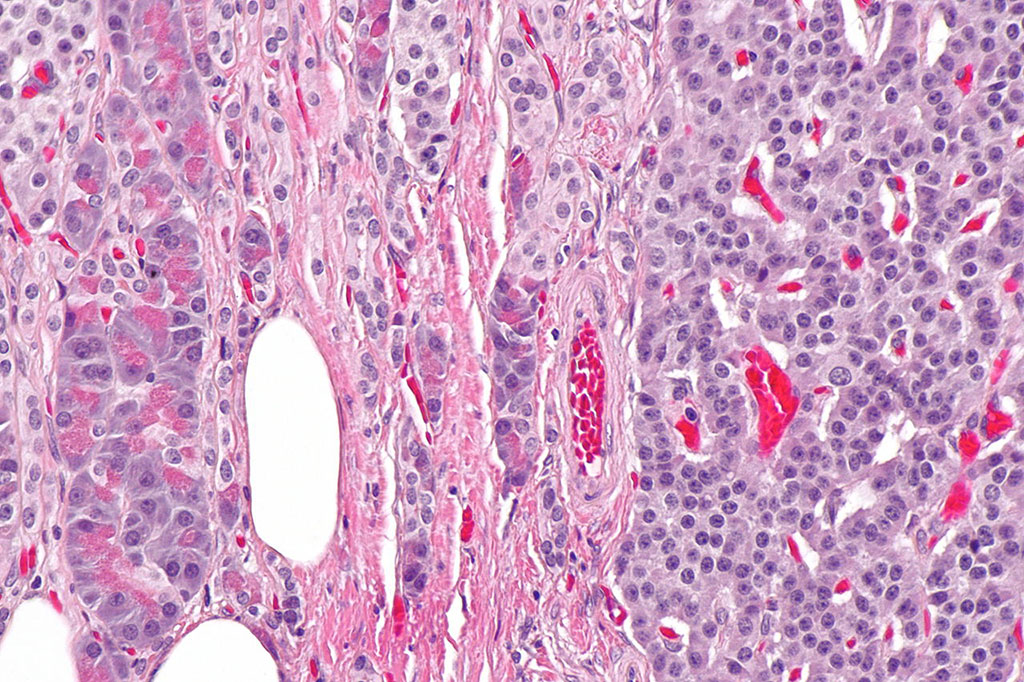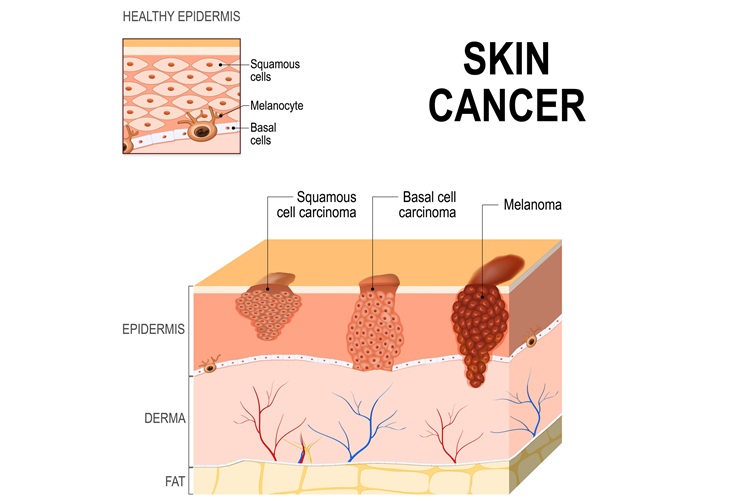Novel Surrogate Marker Described for Pancreatic Neuroendocrine Tumors
|
By LabMedica International staff writers Posted on 19 May 2022 |

Tumors of the endocrine pancreas are a collection of tumor cell types collectively referred to as PanNETs. These tumors originate in islet cells. Although they may be similar or identical in histologic appearance to carcinoid tumors of the gastrointestinal tract, differences in their underlying biology and likely differences in response to therapeutic agents suggest that they should be treated and investigated as a distinct entity.
Pancreatic neuroendocrine tumor (PanNET) is the second most common solid neoplasm of the pancreas, accounting for 3% to 4% of all pancreas neoplasms. The incidence of this tumor has increased owing to advances in various imaging techniques and increasing awareness. Surgical resection is the main treatment option for localized PanNETs, both functioning and nonfunctioning, without distant metastasis.
Pathologists at the University of Ulsan College of Medicine (Seoul, Republic of Korea) assessed the significance of tumor border, a well-known prognostic indicator in other cancers, in the PanNETs. They evaluated the macroscopic growth pattern (expansile [Exp] versus infiltrative [Inf]) and the microscopic tumor border (pushing [Pus] versus Inf) of 203 surgically resected PanNETs and compared them with other clinicopathologic factors.
Growth pattern and tumor border were evaluated at the junctions between tumor and normal pancreatic parenchyma or between tumor and other adjacent organs by both gross and microscopic examination. First, macroscopic growth pattern was evaluated in PanNET cases with available gross images of the cut surface of the PanNETs and was classified as expansile or infiltrative pattern. Expansile growth pattern was defined when the tumor had well-delineated margin from adjacent parenchyma. Microscopic tumor border was categorized as pushing or infiltrative. When the tumor boundary was well circumscribed under microscopic examination, this was referred to as a pushing border. Tissue microarray (TMA) was constructed from archived, formalin-fixed, paraffin-embedded tissue blocks with a manual tissue microarrayer (UNITMA Co Ltd, Seoul, Korea).
The scientists reported that based on macroscopic growth pattern, 83 cases had Exp patterns whereas 84 had Inf patterns. According to microscopic tumor border, 122 PanNETs had Pus borders whereas 81 had Inf borders. Combining macroscopic growth pattern and microscopic tumor border, 65 PanNETs had Exp/Pus, 34 had Inf/Pus, 18 had Exp/Inf, and 50 had Inf/Inf status. PanNETs with Inf/Inf status were associated with higher tumor grade, pT classification, and American Joint Committee on Cancer stage grouping; lymph node metastasis; and lymphovascular and perineural invasion.. Patients with PanNET having Inf/Inf status had significantly shorter overall survival (OS) and recurrence-free survival (RFS). Further, using multivariate analysis, Inf/Inf status was identified as an independent poor prognostic factor of OS and RFS.
The authors concluded that the combined Inf/Inf status was observed in approximately 25% of PanNETs and was associated with aggressive biological behavior and short OS and RFS. Therefore, assessing combined macroscopic growth pattern and microscopic tumor border can provide additional information regarding survival and recurrence in PanNET patients. The study was published on May 9, 2022 in the journal Archives of Pathology and Laboratory Medicine.
Related Links:
University of Ulsan College of Medicine
UNITMA Co Ltd
Latest Pathology News
- New Molecular Analysis Tool to Improve Disease Diagnosis
- Tears Offer Noninvasive Alternative for Diagnosing Neurodegenerative Diseases
- AI-Powered Method Combines Blood Data to Accurately Measure Biological Age
- AI Tool Detects Cancer in Blood Samples In 10 Minutes
- AI Pathology Analysis System Delivers Comprehensive Cancer Diagnosis
- AI Improves Cervical Cancer Screening in Low-Resource Settings
- New Multi-Omics Tool Illuminates Cancer Progression
- New Technique Detects Genetic Mutations in Brain Tumors During Surgery within 25 Minutes
- New Imaging Tech to Improve Diagnosis and Treatment of Skin Cancers
- Serially Testing Brain Tumor Samples Reveals Treatment Response in Glioblastoma Patients
- High-Accuracy Tumor Detection Method Offers Real-Time Surgical Guidance
- AI Tool Detects Hidden Warning Signs of Disease Inside Single Cells
- Automated Tool Detects Early Warning Signs of Breast Cancer
- New Software Tool Improves Analysis of Complex Spatial Data from Tissues
- AI Tool Helps Surgeons Distinguish Aggressive Glioblastoma from Other Brain Cancers in Real-Time
- New Tool Could Revolutionize Acute Leukemia Diagnosis
Channels
Clinical Chemistry
view channel
VOCs Show Promise for Early Multi-Cancer Detection
Early cancer detection is critical to improving survival rates, but most current screening methods focus on individual cancer types and often involve invasive procedures. This makes it difficult to identify... Read more
Portable Raman Spectroscopy Offers Cost-Effective Kidney Disease Diagnosis at POC
Kidney disease is typically diagnosed through blood or urine tests, often when patients present with symptoms such as blood in urine, shortness of breath, or weight loss. While these tests are common,... Read moreMolecular Diagnostics
view channel
Blood Immune Cell Analysis Detects Parkinson’s Before Symptoms Appear
Early diagnosis of Parkinson’s disease remains one of the greatest challenges in neurology. The condition, which affects nearly 12 million people globally, is typically identified only after significant... Read more
New Diagnostic Marker for Ovarian Cancer to Enable Early Disease Detection
Ovarian cancer remains the deadliest gynecological malignancy worldwide, responsible for more than 200,000 deaths annually. Unlike other cancers, ovarian cancer still lacks a reliable screening test.... Read moreHematology
view channel
ADLM’s New Coagulation Testing Guidance to Improve Care for Patients on Blood Thinners
Direct oral anticoagulants (DOACs) are one of the most common types of blood thinners. Patients take them to prevent a host of complications that could arise from blood clotting, including stroke, deep... Read more
Viscoelastic Testing Could Improve Treatment of Maternal Hemorrhage
Postpartum hemorrhage, severe bleeding after childbirth, remains one of the leading causes of maternal mortality worldwide, yet many of these deaths are preventable. Standard care can be hindered by delays... Read more
Pioneering Model Measures Radiation Exposure in Blood for Precise Cancer Treatments
Scientists have long focused on protecting organs near tumors during radiotherapy, but blood — a vital, circulating tissue — has largely been excluded from dose calculations. Each blood cell passing through... Read moreImmunology
view channel
Blood-Based Liquid Biopsy Model Analyzes Immunotherapy Effectiveness
Immunotherapy has revolutionized cancer care by harnessing the immune system to fight tumors, yet predicting who will benefit remains a major challenge. Many patients undergo costly and taxing treatment... Read more
Signature Genes Predict T-Cell Expansion in Cancer Immunotherapy
Modern cancer immunotherapies rely on the ability of CD8⁺ T cells to rapidly multiply within tumors, generating the immune force needed to eliminate cancer cells. However, the biological triggers behind... Read moreMicrobiology
view channel
High-Throughput Enteric Panels Detect Multiple GI Bacterial Infections from Single Stool Swab Sample
Gastrointestinal (GI) infections are among the most common causes of illness worldwide, leading to over 1.7 million deaths annually and placing a heavy burden on healthcare systems. Conventional diagnostic... Read more
Fast Noninvasive Bedside Test Uses Sugar Fingerprint to Detect Fungal Infections
Candida bloodstream infections are a growing global health threat, causing an estimated 6 million cases and 3.8 million deaths annually. Hospitals are particularly vulnerable, as weakened patients after... Read moreTechnology
view channel
Cell-Sorting Device Uses Electromagnetic Levitation to Precisely Direct Cell Movement
Sorting different cell types—such as cancerous versus healthy or live versus dead cells—is a critical task in biology and medicine. However, conventional methods often require labeling, chemical exposure,... Read more
Embedded GPU Platform Enables Rapid Blood Profiling for POC Diagnostics
Blood tests remain a cornerstone of medical diagnostics, but traditional imaging and analysis methods can be slow, costly, and reliant on dyes or contrast agents. Now, scientists have developed a real-time,... Read moreIndustry
view channel
Qiagen Acquires Single-Cell Omics Firm Parse Biosciences
QIAGEN (Venlo, Netherlands) has entered into a definitive agreement to fully acquire Parse Biosciences (Seattle, WA, USA), a provider of scalable, instrument-free solutions for single-cell research.... Read more
Puritan Medical Products Showcasing Innovation at AMP2025 in Boston
Puritan Medical Products (Guilford, ME, USA), the world’s most trusted manufacturer of swabs and specimen collection devices, is set to exhibit at AMP2025 in Boston, Massachusetts, from November 11–15.... Read more
Advanced Instruments Merged Under Nova Biomedical Name
Advanced Instruments (Norwood, MA, USA) and Nova Biomedical (Waltham, MA, USA) are now officially doing business under a single, unified brand. This transformation is expected to deliver greater value... Read more







 Analyzer.jpg)














